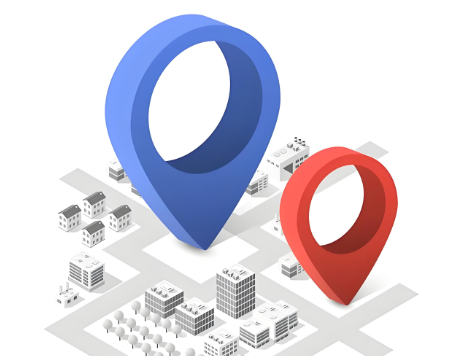As the wave of digitalization sweeps the world, the real-time positioning system (RTLS) has become a key bridge connecting the physical world and the digital space. From equipment tracking in industrial manufacturing to asset monitoring in the medical and health field, from cargo management in smart logistics to personnel positioning in public safety, RTLS technology is reshaping the operating model of various industries by giving objects the ability to "spatial perception".

RFID positioning: spatial mapping in electromagnetic coupling
RFID positioning technology uses electromagnetic waves as a medium to achieve location identification through non-contact interaction between tags and readers. Its core principle can be broken down into three technical levels:
Electromagnetic coupling and energy transmission
RFID systems work based on the principles of electromagnetic induction or electromagnetic backscattering. Passive tags obtain energy through the radio frequency field emitted by the reader, and after activating the internal chip, the stored information is modulated into the reflected signal; active tags have built-in batteries and can actively transmit signals. This energy transmission mechanism determines the recognition range (usually 0.1-15 meters) and tag life of RFID, and also provides a basic signal source for its positioning function.
Signal feature extraction and spatial association
During the positioning process, the system constructs a spatial model by analyzing characteristic parameters such as signal strength (RSSI), arrival time (TOA) or arrival angle (AOA). RSSI positioning uses the mathematical relationship between signal attenuation and distance to solve the tag position through the difference in signal strength received by multiple readers; TOA positioning calculates the distance by measuring the signal propagation time, which requires strict clock synchronization; AOA positioning relies on the antenna array to sense the signal incident angle, which requires high hardware accuracy.
Multi-dimensional data fusion and error correction
In order to cope with multipath effects and signal interference in complex environments, modern RFID positioning systems introduce multi-sensor fusion technology. By fusing inertial sensor data such as accelerometers and gyroscopes, combined with Kalman filtering or particle filtering algorithms, positioning drift in dynamic environments can be effectively suppressed. At the same time, the signal fingerprint library technology based on machine learning collects environmental feature data offline and achieves high-precision positioning through online matching, significantly improving the robustness of the system.
UWB positioning: the ultimate breakthrough in time resolution
UWB technology advances positioning accuracy to the centimeter level through time ranging of nanosecond pulse signals. Its technical advantages are reflected in three core dimensions:
The spatiotemporal characteristics of ultra-wideband pulses
UWB signals use narrow pulses with extremely short duration (usually less than 1 nanosecond), corresponding to a spatial resolution of 30 centimeters. Its spectrum covers an ultra-wide range of 3.1-10.6GHz, and its power spectrum density is extremely low. It can penetrate non-metallic obstacles such as concrete and avoid interference with other wireless systems. This spatiotemporal characteristic enables UWB to maintain high-precision positioning capabilities in complex environments.
Two-way ranging and time synchronization mechanism
UWB positioning mainly uses the two-way time of flight method (TW-TOF) or time difference (TDOA) algorithm. TW-TOF calculates the distance by measuring the round-trip time of the signal, and requires the tag to be accurately synchronized with the base station clock; TDOA constructs a hyperbolic positioning model through the time difference of receiving signals from multiple base stations, and has low requirements for clock synchronization. Modern UWB systems control the ranging error within 10 cm by introducing timestamp exchange protocols and hardware-level time compensation technology.
Technological evolution: from scene adaptation to paradigm innovation
The technical division between RFID and UWB is essentially the art of balancing positioning needs and implementation costs. Its evolution trend presents three major characteristics:
Gradient coverage of accuracy and cost
RFID meets the needs of large-scale asset identification with meter-level accuracy, and the cost of a single tag is as low as US$0.1, which is suitable for low-precision scenarios such as warehouse management; UWB supports high-risk applications such as industrial automation and unmanned driving with centimeter-level accuracy, and the cost of a single tag is about US$40-120, which is suitable for core links that are sensitive to accuracy. The two form a complementary technical ecosystem.
Continuous optimization of environmental adaptability
RFID expands its application capabilities in metal-dense environments through multi-band adaptation (low frequency, high frequency, ultra-high frequency) and anti-metal tag design; UWB improves positioning stability in non-line-of-sight environments through multipath separation algorithms and channel estimation technology. Technological iteration always revolves around the core challenge of environmental adaptability.
Convergence trend of heterogeneous systems
Modern RTLS solutions are evolving from a single technology to a fusion of multiple technologies. For example, combining the high precision of UWB with the large-scale tag management capabilities of RFID to build a hybrid positioning system with "high precision in the core area + wide-area coverage and low cost"; or integrating existing infrastructure such as Bluetooth and Wi-Fi to reduce deployment costs. This integration trend marks the move of RTLS technology towards platformization and intelligence.
From RFID's electromagnetic induction to UWB's time-to-distance measurement, the evolution trajectory of RTLS technology reveals a core law: every order of magnitude increase in positioning accuracy is accompanied by the outbreak of new application scenarios. When UWB compresses the positioning error to 1/10 of the human stride, scenarios such as precise management of operating room instruments, safe boundaries of human-machine collaboration in factories, and millimeter-level obstacle avoidance between vehicles in autonomous driving become possible.